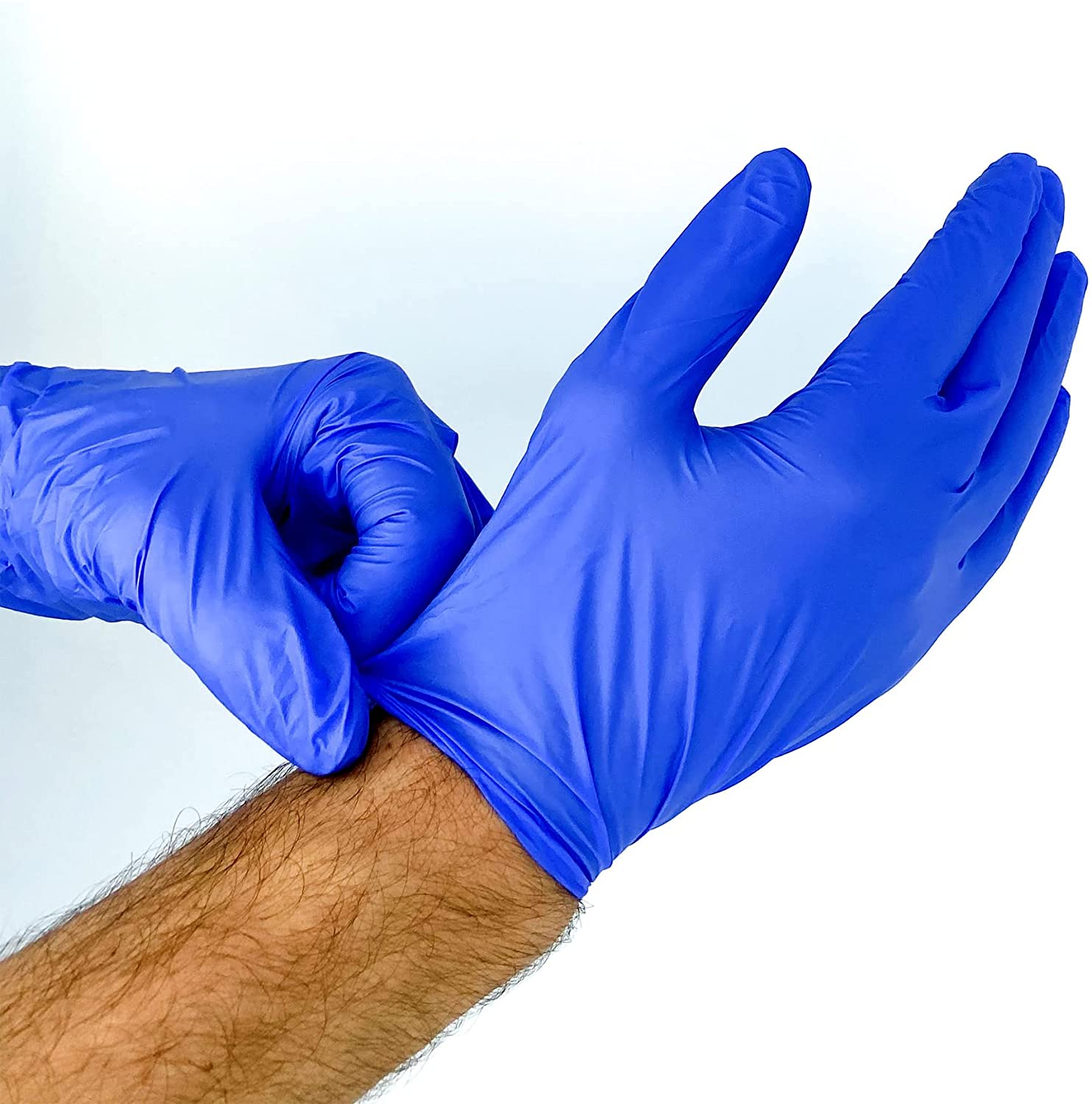- Your cart is empty
- Continue Shopping
Determination of Nitrile Gloves Appropriate for Use When Dry Handling Art

ABSTRACT
Nineteen brands of latex-free, powder-free, disposable nitrile glove were investigated for use when dry handling art. Results from a rub test, a modified Oddy test, scanning electron microscopy-energy dispersive spectroscopy (SEM-EDS), and ion chromatography (IC) were combined to identify gloves that caused the least damage to artificially aged metal coupons. The rub test involved repeated wiping of lead (Pb), copper (Cu), and silver (Ag) coupons with donned gloves then visually assessing the result to look for evidence of deposited residues. Ten brands deposited residues. The modified Oddy test studied the impact of glove handling on evidence of coupon corrosion. Twelve glove brands instigated moderate to severe corrosion of the coupons during artificial aging. SEM-EDS data showed that deposited residues led to pitting and corrosion of coupon surfaces with the presence of chlorine and oxygen dominating corrosion sites. Larger amounts of chloride ions (Cl–) in gloves were affiliated generally with greater corrosion. Ansell Bioclean™ Biotac white cleanroom and Showa® 7500PF blue economy grade gloves deposited no visible residues, induced minimal corrosion, and showed lower anion contents relative to other gloves, making them the best brands tested here for dry handling art.
RÉSUMÉ
Dix-neuf marques de gants de nitrile jetables sans poudre et sans latex furent testées pour leur utilisation dans la manipulation à sec d’œuvres d’art. Les résultats d’un essai de friction, d’un test Oddy modifié, des analyses par microscope électronique à balayage – spectromètre en énergie dispersive (https://context.reverso.net/translation/french-english/MEB-SDE MEB-SDE) et de la chromatographie par ions ont été combinés pour identifier les gants causant le moins de dommage à des coupons de métal vieillis artificiellement. Le test par friction impliquait de frotter à répétition les coupons de plomb (Pb), de cuivre (Cu) et d’argent (Ag) en portant chaque type de gants, puis d’en évaluer visuellement le résultat, en quête de traces de résidus déposés. Dix des marques à l’étude laissaient des résidus. Le test Oddy modifié a étudié l’impact des manipulations gantées sur la corrosion des coupons. Douze marques causèrent une corrosion modérée à sévère des coupons pendant le vieillissement artificiel. Les données MEB-SDE démontrèrent que le résidu ainsi déposé entraîna la corrosion par piqures et la corrosion des surfaces des coupons, la présence de chlorure et d’oxygène dominant les sites corrodés. De plus grandes quantités d’ions à chlorure (Cl–) dans les gants furent généralement associées à une plus grande corrosion. Les gants « Ansell Bioclean™ Biotac white cleanroom » et « Showa® 7500PF blue economy grade » ne laissèrent pas de résidu visible, causèrent une corrosion minimale, et entraînèrent une présence moindre d’anion comparé à d’autres gants, faisant d’elles les meilleures marques testées ici pour les manipulations à sec d’œuvres d’art. Traduit par Monique Benoît et Martin Milette.
RESUMO
Dezenove marcas de luvas nitrilIcas descartáveis sem latex e sem talco foram investigadas para uso no manuseio de arte. Os resultados de um teste de fricção, um teste de Oddy modificado, microscopia eletrônica de varredura com espectroscopia de energia dispersiva (MEV-EED) e cromatografia iônica (IC) foram combinados para identificar as luvas que causaram menos danos as amostras de metal envelhecidas artificialmente. O teste de fricção consistiu na limpeza repetida de amostras de chumbo (Pb), cobre (Cu) e prata (Ag) com luvas vestidas, seguida da avaliação visual do resultado a procura de evidências de resíduos depositados. Dez marcas depositaram resíduos. O teste Oddy modificado estudou o impacto do manuseio das luvas sobre as evidências de corrosão da amostra. Doze marcas de luvas provocaram corrosão moderada a severa das amostras durante o envelhecimento artificial. Os dados do MEV-EED mostraram que os resíduos depositados levaram à corrosão pontual e corrosão das superfícies do cupom com a presença de cloro e oxigênio dominando os locais de corrosão. Quantidades maiores de íons cloreto (Cl–) em luvas geralmente estavam associadas a maior corrosão. As luvas Ansell Bioclean™ Biotac brancas para sala limpa e Showa® 7500PF azul do tipo econômico não depositaram nenhum resíduo visível, causaram corrosão mínima e apresentaram menor teor de ânions em relação a outras luvas, tornando-as as melhores marcas testadas aqui para manuseio de arte. Traduzido por Marcia Rizzo.
RESUMEN
Se investigaron diecinueve marcas de guantes de nitrilo desechables sin látex, sin polvo, para uso en la manipulación en seco de obras de arte. Los resultados de una prueba de frotamiento, una prueba Oddy modificada, una espectroscopia dispersiva de energía con microscopía electrónica de barrido (SEM-EDS) y una cromatografía iónica (IC) se combinaron para identificar los guantes que causen el menor daño a los cupones de metal envejecidos artificialmente. La prueba de frotamiento implicó la limpieza repetida de cupones de plomo (Pb), cobre (Cu) y plata (Ag) con los guantes puestos y luego se evaluó visualmente el resultado para buscar evidencia de residuos depositados. Diez marcas depositaron residuos. La prueba Oddy modificada estudió el impacto de la manipulación de los guantes sobre la evidencia de corrosión del cupón. Doce marcas de guantes provocaron una corrosión de moderada a severa de los cupones durante el envejecimiento artificial. Los datos de SEM-EDS mostraron que los residuos depositados condujeron a pequeñas perforaciones y corrosión de las superficies de los cupones con la presencia de cloro y oxígeno que dominan los sitios de corrosión. Cantidades mayores de iones de cloruro (Cl-) en los guantes se asociaron generalmente con una mayor corrosión. Los guantes Ansell Bioclean™ Biotac white cleanroom y Showa® 7500PF azul de grado económico no depositaron residuos visibles, indujeron una corrosión mínima y mostraron un contenido de aniones más bajo en comparación con otros guantes, lo que los convierte en las mejores marcas de las probadas aquí para la manipulación de arte en seco. Traducción: Amparo Rueda.
Acknowledgments
Research conducted at The Metropolitan Museum of Art was supported by the Institute of Museum and Library Services (IMLS) National Leadership Grant [MG-30-16-0083]. Alayna Bone is thanked for her assistance during modified Oddy testing and photography work. The information discussed here is intended to be used for general reference and The Metropolitan Museum of Art does not endorse, approve, or recommend any product. Readers are solely responsible for determining appropriate products and treatment for their individual circumstances.
Disclosure statement
No potential conflict of interest was reported by the author(s).
Additional information
Funding
This work was supported by the Institute of Museum and Library Services [grant number MG-30-16-0083].
Notes on contributors
Catherine H. Stephens
Catherine H. Stephens has a PhD in macromolecular science and engineering from Case Western Reserve University as well as bachelor’s degrees in Chemistry and Art History from SUNY Geneseo. Her current work focuses on analyzing the chemical composition and performance properties of materials slated for use near artwork. Previously, her conservation science studies focused on understanding the degradation behavior of synthetic and natural polymers found in cultural heritage environments. Address: The Metropolitan Museum of Art, Department of Scientific Research, 1000 Fifth Avenue, New York, NY 10021. Email: catherine.stephens@metmuseum.org.
Eric M. Breitung
Eric M. Breitung has a PhD in physical organic chemistry from the University of Wisconsin, Madison. He currently leads the Preventive Conservation Science Laboratory focusing on minimizing the impact of the chemical and physical environments on cultural heritage materials. Prior studies include the development of tools and techniques to rapidly identify degraded polymeric materials and to reduce the corrosion rate of silver and copper-based metals, work that was initiated during his tenure at General Electric’s Global Research Center. Address: same as Stephens. Email: eric.breitung@metmuseum.org.
Corina Geiculescu
Corina Geiculescu has been working for the last 20 years as a Principal Scientist in the Research & Development Department at Abbott in Liberty, SC. She holds a BS/MS degree in Organic Chemical Technology (Bucharest, Romania), a MS degree in Chemical Engineering (Clemson University, SC, USA) and a PhD degree in Physical Chemistry (Clemson University). Before joining Abbott (formerly St. Jude Medical), Dr. Geiculescu worked in the materials science/ceramics/fibers and films area, being involved in materials characterization and implementation of new and original processes for the Air Force, Navy and automotive industries. She has published numerous scientific papers, authored patents, and has participated at various conferences, both in the USA and internationally. Address: Abbott R&D Department 253 Financial Blvd. Liberty, SC 29657 USA. Email: corina.geiculescu@abbott.com.
Thomas Strange
Thomas Strange is the Executive Director and Chief Curator at the Sigal Music Museum in Greenville, South Carolina. An accomplished builder and restorer of keyboard instruments, Strange has presented lectures, concerts, and papers on early piano development throughout the United States and Europe. In 2016, Strange and a small group of partners founded the Carolina Music Museum, which became the Sigal Music Museum in 2019 following a major gift from the Marlowe Sigal estate. In addition to his work with early keyboard instruments, Thomas has an extensive background in materials science and is the author of fifty-five patents and numerous papers over the last three decades, covering all aspects of medical device component development. Following his undergraduate and graduate degrees in Physics at the University of South Carolina, he entered the field of medical device electronic components in 1993. His team created the Power Technologies Group for Abbott, defining the state-of-the-art in implantable medical devices for arrhythmia correction and neuromodulation. Email: tom@sigalmusicmuseum.org.








